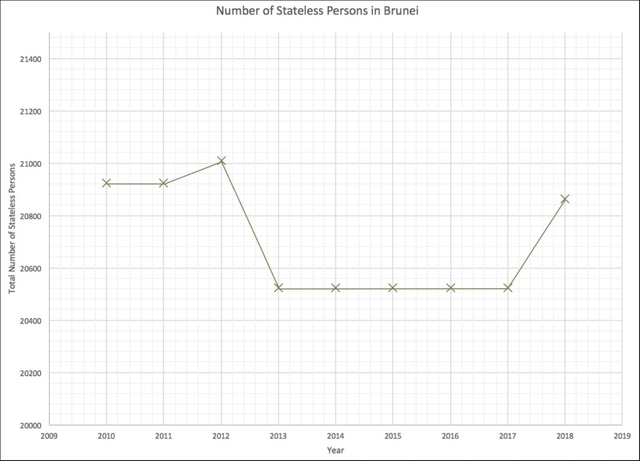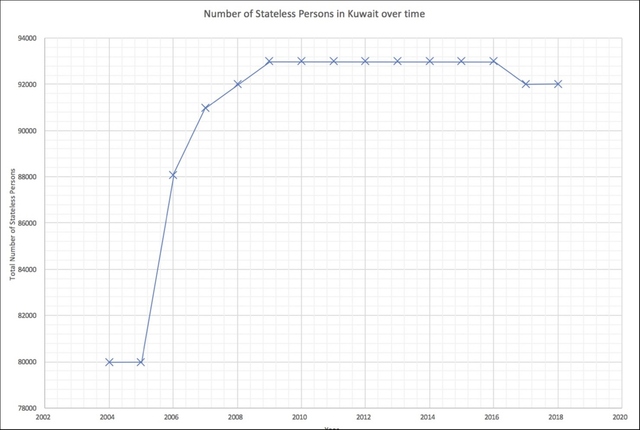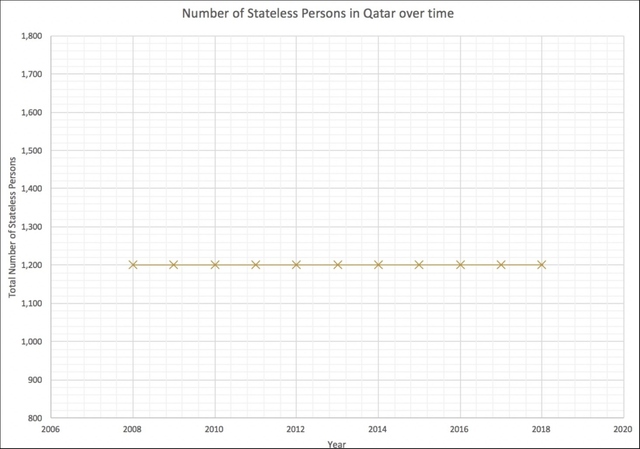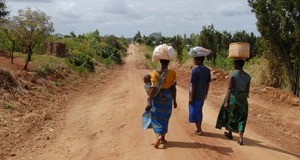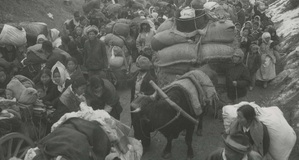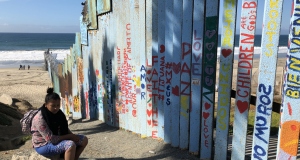The Impact of Gender Discrimination on Statelessness: A Case Study of the Impact of Nationality Laws on Statelessness
By
2022, Vol. 14 No. 04 | pg. 1/1
IN THIS ARTICLE
KEYWORDS
AbstractWith over 10 million stateless people globally, statelessness has increasingly become a pressing issue in international law. The production of statelessness occurs across multiple lines including technical loopholes, state succession, and discriminatory legislation. This study assesses how gender-based discrimination in nationality laws impacts the incidence of statelessness. There are seven countries whose citizenship laws forbid women to confer their nationality to their children with little to no exceptions. This study examines five of these seven countries where sufficient, reliable information is available: Brunei, Iran, Kuwait, Lebanon, and Qatar. A graphical analysis for the countries with available data (Brunei, Kuwait, and Qatar) is conducted using UNHCR’s ‘persons of concern’ database. In addition, a qualitative analysis using literature from the UN, the US Department of State, the Institute on Statelessness and Inclusion as well as other academic journals is conducted for all five countries. With the exception of Qatar, gender-based discrimination stands as a key producer of statelessness in these countries. The study recommends that these policies are amended to ensure the even conferral of nationality as well as the inclusion of straightforward naturalization systems to mitigate statelessness. IntroductionStatelessness is defined by the United Nations High Commissioner for Refugees (UNHCR) as people who are “not considered a national of any State by operation of its law” (UN High Commissioner for Refugees, 2012). These are people who do not have citizenship and aren’t afforded many human rights in the nation-state in which they find themselves, making them highly vulnerable individuals. Due to the undocumented nature of statelessness and the legal difficulties many stateless people experience, it can be hard to pinpoint the extent to which statelessness impacts the world. Nonetheless, the UNHCR has been able to estimate the presence of over 10 million stateless people worldwide (UN High Commissioner for Refugees, 2012). Stateless people are unremittingly affected by their lack of nationality. The inability to make a legal claim to a number of rights, protections, and services in a particular country prohibits stateless persons from being able to completely engage in their respective communities. There are a multitude of factors that can lead to statelessness; some cases are quite specific while others are part of larger national processes. In general, most causes can be divided into three categories: state succession, technical loopholes, and discriminatory nationality laws (Batchelor, 1998).Statelessness caused by state succession takes place when an already existing nation-state is dissolved, separated, or unified into another nation-state. This can also take place if the territory of a particular region is transferred from one state to another (Batchelor, 1998). This can be a cause of statelessness if, for whatever reason, populations fail to secure citizenship in the successive state. For instance, after the Soviet Union’s dissolution many of its former citizens had already sought asylum in other parts of the world. Many of these former citizens were unable to meet the citizenship requirements of the countries that emerged out of the fall of the Soviet Union, despite being born and having previously lived in those territories. In general, the demarcation of national borders in the wake of state succession has consistently caused statelessness (European Network on Statelessness, 2014). Another leading factor in the production of statelessness involves technical causes. People can become stateless due to unintended gaps or conflicts in nationality and citizenship laws. The most common technical loophole is the incompatibility between countries that confer citizenship through descent and countries that grant citizenship by birth. Someone born in a country that mainly recognizes citizenship by descent cannot automatically acquire citizenship if the parents hail from a country that grants citizenship by birth. Other technicalities can also render people stateless later on in life. The UNHCR lists some of the more common ones as “not providing nationality to abandoned children found on the territory; automatic loss of nationality of individuals who reside abroad without registering with a consulate after a specified period of time; procedural formalities upon the marriage of a national of a country to a non-national who, by virtue of that marriage, does not retain his or her citizenship in their home country” (UN High Commissioner for Refugees, 2012). There are a number of administrative barriers that can not only produce statelessness but also perpetuate it. Many naturalization processes involve expensive fees and onerous requirements that make citizenship inaccessible to many groups. Nomadic and migrant communities tend to suffer from such requirements (Beaugrand, 2011). Finally, statelessness is also largely caused by discrimination and the arbitrary deprivation of nationality. This type of discrimination can happen across, ethnic, racial, religious, gendered, and even linguistic lines. In most cases, the deprivation of nationality is always considered arbitrary unless it serves a valid purpose and fulfills procedural standards. This can only involve very limited exceptions; thus, in most cases the deprivation of nationality is considered unjustified and addressed as a form of legal discrimination by the UNHCR. Many nation-states use policies that disproportionately affect a minority or a particular group to do this, depriving people of nationality at birth or later on in life (UN High Commissioner for Refugees, 2012). Currently, there are 26 countries which uphold gender-discriminatory legislation that unevenly limits a mother’s ability to confer their nationality onto their children compared to the father. This study will center around these gender-discriminatory citizenship laws, with a particular focus on the countries which employ the strictest forms of gender-discrimination in the conferral of nationality. Out of the 26 countries that have nationality legislation that discriminates on the basis of gender, seven have laws that completely forbid mothers to confer their nationality onto their children with no, or extremely limited, exceptions. These seven countries are: Iran, Kuwait, Brunei, Somalia, Swaziland, Qatar, and Lebanon (UN High Commissioner for Refugees, 2013). BackgroundAlthough the exact origins of statelessness are unclear, slaves living in Greco-Roman territories during classical antiquity (c. 800 BC – 700 AD) are the most comparable group to modern statelessness. During this time period, slavery was so imbedded in Roman culture that it remained uncontested and practically invisible for society at large. Slavery was accepted as fact and seen as a natural product of Greco-Roman society (Cartwright, 2013). Characteristics of statelessness have been observable during other time periods in various regions as well; however, statelessness did not become a key phenomenon until the 20th century. Prior to World War 2, only one case of statelessness had ever been addressed by the international community during a League of Nations conference in 1930. During the war, the League of Nations provided stateless refugees with internationally recognized identity cards (Giaimo, 2017). The instability caused by World War 2 led to unprecedented levels of displaced people and statelessness. Thus, with the emergence of the 1948 Universal Declaration of Human Rights, statelessness started being addressed more systematically. Article 15 of the 1948 declaration stipulates that everyone has the right to a nationality (United Nations, 1948). In 1950 a Committee on Refugees and Stateless People, which would go on to become the UNHCR, was appointed by the UN’s Economic and Social Council (ECOSOC) to draft a convention. The next year, the 1951 Refugee Convention was adopted, which set a precedent in international law by defining what constitutes a refugee and outlining the rights of individuals seeking asylum. The 1954 Convention relating to the Status of Stateless Persons was developed as an accompanying protocol to the original refugee convention of 1951. This convention established the universal definition of a stateless person and outlined some criteria that countries should institute to prevent statelessness. These criteria aimed “to regulate and improve the legal status of stateless persons residing on their territory and to ensure non-discriminatory protection of their fundamental rights and freedoms” (UN High Commissioner for Refugees, 2012, p. 11). This was followed by the 1961 Convention on the Reduction of Statelessness where nation-states committed themselves to tackling statelessness more directly (Weis, 1962). Hence, the arbitrary deprivation of nationality is in diametric opposition with international human rights declarations. During the decades following the adoption of these two conventions, stateless individuals received relatively minor attention from the international community. The issue of statelessness didn’t enter the political spotlight until the dissolution of the Soviet Union and the break-up of former Yugoslavia during the 1990s. The UNHCR notes that since World War 2 around 100 new nation-states have emerged. It wasn’t until 1994 that the UNHCR broadened their mandate to include all states (UN High Commissioner for Refugees, 2004). Although UN conventions make up the majority of the frameworks for responding to statelessness, regional conventions have also addressed the issue. The European Convention on Nationality was signed in 1997 and has contributed to the protection of stateless people in Europe while providing guidelines for reducing statelessness. The convention also underlines the importance of administering a nationality to all people (Council of Europe, 2020). Regional and international initiatives have continued throughout the 21st century as statelessness prevails and new cases emerge. However, despite these continued efforts, many scholars argued that the issue did not garner a significant degree of international attention up to the early 21st century. Kingston (2013, p. 74) affirms that statelessness “serves as an example of a social problem that has not yet fully emerged onto the international human rights agenda, yet reasons for its slow progress are rarely discussed.” This can be due to the complexities that statelessness entails. There is an absence of a clear problem since stateless individuals can be intangible actors within international and political systems. The lack of available data also feeds into the intangibility of the issue. It’s hard for statelessness to garner media coverage when the narratives that surround it can be so diverse and complex. Additionally, it’s easy to misunderstand the concept of statelessness; stateless individuals are often confused with asylum-seekers or associated with national security threats. Finally, statelessness lacks a widely understood, global solution due to the complexity of the issue which can also act as a barrier to issue emergence (Kingston, 2013). With an estimated 10 million stateless persons in the 21st century, one third of which are children (UN High Commissioner for Refugees, 2016), statelessness persists unabated by the contemporary frameworks of international law, leaving millions of people trapped in political limbo. Literature ReviewTo understand the notion of statelessness, the concept of nation-states must be broken down. Political scientist and historian Benedict Anderson published a book named Imagined Communities which reframed the conversation surrounding nationalism and statehood. Anderson argues that nations are socially constructed entities which he defines as ‘imagined communities’ that are both limited and sovereign. He states that nations are imagined because no individual will ever know or hear of everyone within their nation regardless of how small the populace is. Nonetheless, this imagined perception of a nation provides people with a sense of belonging. This is what makes it possible for people to put their lives on the line for their country. These imagined communities are also limited because no nation imagines that everyone on the planet belongs to it (Anderson, 2006). Other scholars have also contributed to Anderson’s notion of imagined communities. Thomas Biolsi builds on Anderson’s work by discussing many of the ways in which territory and sovereignty don’t match neatly. Despite being an abstract concept, territorial sovereignty has very palpable consequences. Biolsi outlines various cases where sovereignty can have overlaps, contradictions, and irregularities (Biolsi, 2005). Viewing nation-states through the lens of imagined communities provides an explanatory framework to understand the problem of statelessness. Statelessness is a condition that can only exist in a system with imagined communities; it’s a problem that derives from the idea that imagined communities are limited. Moreover, as Biolsi (2005) outlines, the socially constructed nature of sovereignty can also lead to asymmetries in international law. Thus, it’s perhaps these social constructs that entrench and perpetuate statelessness in the first place. There is some literature that bridges the gap between statelessness and gender. Stratton (1992) discusses the ways in which gender dynamics impact statelessness. Stratton outlines the generic ways in which gender discrimination in nationality laws can be problematic, which were previously outlined. Stratton’s paper examines different instances of international law circumscribing human rights as well as cases of gender discrimination in nationality laws. Stratton goes on to detail some of the international treaties and conventions created to address these issues; the most comprehensive one being The Convention on the Elimination of all Forms of Discrimination Against Women (CEDAW) instituted in 1981. The convention explicitly forbids gender-based discrimination in nationality laws and demands full equality with men in the conferral of nationality (Stratton, 1992). Although this paper bridges the gap between gender and statelessness, it does not assess the extent to which these discriminatory laws can cause statelessness. Stratton’s analysis focuses on the nuances of international law rather than the specific countries that implement gender-discriminatory policies and the impact they have on their respective populations. Other literature also focuses on gender discrimination within the context of statelessness. Edwards (2009) explains how the mandate of CEDAW is applicable to displaced and stateless persons affected by gender discrimination. This background paper summarizes the purview of CEDAW and argues that it can supplement the UNHCR’s supervisory role for the welfare of displaced and stateless people (Edwards, 2009). Additionally, Petrozziello (2018) also discusses gender discrimination and statelessness with a focus on Haitian migrants in the Dominican Republic. This research article examines indirect gender discrimination in the Dominican Republic’s political system as a way to restrict access to citizenship. The focal point of the article centers around how these discriminatory policies affect individuals of Haitian descent and the production of statelessness (Petrozziello, 2018). Finally, some of the seven countries listed previously have external factors that affect their level of statelessness. The majority of the literature surrounding statelessness in Lebanon assesses ethnicity as a key factor. Lebanon has a number of ethnic groups, such as Palestinians and Kurds, which can be stateless due to reasons that don’t pertain to the uneven conferral of nationality across genders. Nevertheless, statelessness that occurs across ethnic lines tends to also be caused by discriminatory policies as well (Tucker, 2014). Furthermore, Kuwait’s statelessness literature primarily involves an analysis of how the Bidoon minority has been unable to obtain Kuwaiti citizenship due to the nomadic nature of their livelihoods (Beaugrand, 2011). This literature is factored into the analysis of this study in order to contextualize the data and other information gathered on their stateless populations. It’s also important to note that ethnicity and gender are not demographics that can be decisively disentangled from each other within the context of statelessness. The intersections of different identities can impact how people are treated under the law of a particular country. This study aims to build on the existing literature by conducting a specific policy analysis on all countries that strictly forbid women to confer their nationality. This study assembles qualitative literature and statelessness data to examine the extent to which these policies increase statelessness in the countries that continue to implement them. MethodologyCase StudyThere are various manifestations of gender-based discrimination in affording nationality, all of which have different impacts on the livelihoods of the people living within a country. There are 29 countries that have laws that cause women to unevenly confer nationality to their children compared to men (Stratton, 1992). Within this group, seven countries have laws that completely forbid women to confer their nationality to their children with no, or extremely limited, exceptions. These seven countries are: Iran, Kuwait, Brunei, Somalia, Swaziland, Qatar, and Lebanon (UN High Commissioner for Refugees, 2013). Due to a lack of qualitative and quantitative data availability for Somalia and Swaziland as well as the particular geopolitical context surrounding Somalia’s statehood, they will be omitted from this study. Somalia’s state collapsed in 1991 when the country’s administration was ousted by a coalition of opposition groups (Schlee, 2013). The country entered a civil war over its statehood. A federal government was established in 2012 but the country is still considered a fragile state by international organizations and continues to rank highly, if not first, on the Fragile States Index (FSI) (Messner, 2014). Somalia’s statehood presents confounding variables that this paper cannot properly overcome with the current level of data availability. Moreover, there is not enough numerical or qualitative data on Swaziland to conduct a thorough assessment. Hence, this paper’s case study will involve Brunei, Iran, Kuwait, Lebanon, and Qatar. Graphical AnalysisA graphical analysis using UNHCR data on the number of stateless people in the applicable countries is used to map out the incidence of statelessness over time. The UNHCR provides global figures on “persons of concern.” This encompasses refugees, asylum-seekers, internally displaced people (IDP), stateless individuals, returnees and others. The database also includes figures for each of these sub-groups for various countries. However, as mentioned previously, statelessness can be difficult to measure. This database contains some gaps over time as well as a general lack of data for many countries. It’s important to note that the UNHCR does not count refugees as stateless individuals in its statistics. Stateless refugees are counted as refugees in order to prevent double counting (UN High Commissioner for Refugees, 2018). Graphs for each of the countries with sufficient data have been created. These countries are Brunei, Kuwait, and Qatar. The graphs are accompanied by descriptive analyses which will be contextualized with qualitative evidence. Qualitative AnalysisThe majority of the qualitative analysis is conducted through a review of country-specific literature on statelessness for all five countries. This literature comes from the UNHCR, the Institute on Statelessness and Inclusion and various academic journals. Appendix A lists all the sources involved in this qualitative analysis. The main sources employed are discussed in further detail below. The US Department of State provides country reports describing how different states grant and protect human rights. These country reports have supplemented Brunei (US Department of State, 2014) and Qatar’s (US Department of State, 2010) analyses. A report assessing gender discrimination and statelessness in the Gulf Cooperation Council informs a large portion of the analysis on Qatar and Kuwait (Fisher, 2015). Further literature on Kuwait comes from a Middle East Institute study that assesses Kuwait’s gender-based policies more broadly (Tétreault & al-Mughni, 1995). Two University of Bath studies present key information on Lebanon and Iran. The first discusses Lebanon’s citizenship policies as a whole (Tucker, 2013) whereas the second examines statelessness within Iran and its leading causes (Tucker, 2014). Finally, a submission to the Human Rights Council published by the Institute on Statelessness and Inclusion and other related organizations details Brunei’s causes of statelessness and examines the country’s nationality policies (Institute on Statelessness and Inclusion et al, 2019). Results & AnalysisBruneiFigure 1: Total Number of Stateless Persons in Brunei over time (UN High Commissioner for Refugees, 2018) Figure 1 depicts the number of stateless people in Brunei since 2010. Although the graph shows some fluctuations, Brunei’s stateless population has remained quite steady. The more notable variations occurred in 2012 - 2013 with a drop of 485 people and in 2017 - 2018 with an increase of 339 people. Brunei is currently considered to have 20,863 stateless individuals per the UNHCR’s most recent estimate. This is about 4.9% of the country’s total population in 2018 (UN High Commissioner for Refugees, 2018). The Brunei Nationality Act of 1961 is the main legal framework for the provision and loss of Bruneian nationality. Citizenship is derived through descent rather than birth within the country. This legislation only allows fathers to confer their nationality to their children with no exceptions. Due to Brunei’s relatively strict citizenship laws, the government makes a number of distinctions between citizens, stateless permanent residents (PRs), and stateless persons without any legal status. Stateless PRs are ‘registered’ members of Bruneian society who don’t enjoy the same degree of benefits that citizens do but can still access limited amenities. Stateless PRs are not authorized to own land and cannot receive fully subsidized higher education or health care; they have certificates of identity instead of passports which allow them to travel internationally and apply for foreign visas (Government of Brunei, 1962). However, there are multiple cases of stateless PRs being denied entry to other countries or being questioned for prolonged periods of time due to immigration officers failing to recognize these certificates as legitimate. Stateless individuals without PR status receive no benefits from the Bruneian government. These individuals are not able to obtain identification documents either (Institute on Statelessness and Inclusion et al., 2019). The Brunei Nationality Act forbids citizen mothers from conferring their nationality to their children with no exceptions. Nationality can only be conferred through a citizen father. Hence, when citizen mothers have a child and the father is not present they must apply for a certificate of identity to register their child as a stateless PR. As mentioned previously, children registered as stateless PRs will have limited access to government-related services (Institute on Statelessness and Inclusion et al., 2019). Moreover, women are also prohibited from conferring their nationality to a foreign spouse whereas a foreign woman married to a male citizen will acquire citizenship. This can perpetuate statelessness if a woman’s husband is already stateless (Institute on Statelessness and Inclusion et al., 2019). Incidentally, Brunei’s legislation also discriminates on the basis of race by restricting nationality to one of the seven ‘indigenous groups’ of the Malay race (Government of Brunei, 1962). The Bruneian government does not consider the Iban population as part of this group despite their indigenous heritage to Brunei, Malaysia, and Indonesia (Institute on Statelessness and Inclusion et al., 2019). Some of the common non-Malay ethnicities in Brunei include Chinese individuals (10.1%), and other foreign-born people (23.9%) mostly hailing from other southeast Asian countries (Minority Rights Groups International, 2019). A country report on human rights practices by the US Department of State (2014) indicates that a large portion of stateless individuals in Brunei are of Chinese or aboriginal descent. The report also states that a large percentage of the country’s indigenous Iban population is also stateless. Although birth registration acts as a tool to prevent complete statelessness, indigenous populations in rural areas experience administrative barriers to accessing this registration (US Department of State, 2014). Other sources estimate that around half the ethnic Chinese population in Brunei is stateless (Minority Rights Groups International, 2009). Although the Bruneian government provides a system through which stateless PRs can become citizens, the strict application requirements can create barriers for stateless PRs. For instance, proficiency in both the standard Malay language as well as the informal Malay dialect spoken in Brunei are required for citizenship (Government of Brunei, 1962). This colloquial Malay dialect contains substantial linguistic differences compared to standard Malay. Hence, mastery of both types of Malay can be difficult for stateless persons with limited access to public education. Moreover, case reports indicate that many stateless PRs who met the qualifications for citizenship and passed the exam were left waiting 5 to 10 years before being afforded citizenship (Institute on Statelessness and Inclusion et al., 2019). Given that stateless persons make up around 5% of the country’s entire population, Brunei is considered to have a high incidence of statelessness (Institute on Statelessness and Inclusion et al., 2019). It should be noted that other sources report far higher figures of statelessness. The US country report suggests that the stateless population is closer to 150,000 people (US Department of State, 2014). Additionally, the consistency in the level of statelessness in Brunei over time suggests that the country has made little to no effort to address the issue. Brunei is not a signatory state of the 1951, 1954 and 1961 refugee and statelessness conventions outlined in the Background section. However, the country has ratified other human rights conventions including, but not limited to: CEDAW, the Convention on the Rights of the Child (CRC), and the Convention on the Rights of Persons with Disabilities (CRPD). All of these conventions contain articles urging countries to provide nationality without discrimination. Moreover, during the Second Universal Periodic Review Cycle of 2014, Brunei received an extensive number of recommendations from other countries to amend its gender discriminatory nationality laws. Brunei rejected these recommendations arguing that there are procedures available for stateless PRs to obtain citizenship (Government of Brunei, 1962). It’s difficult to pinpoint the impact of gender-discriminatory legislation on the country’s statelessness since ethnic discrimination and administrative barriers are also contributing factors. However, gender-based discrimination in Brunei is typically accompanied by convoluted administrative procedures anyway. Hence, it can be relatively easy for a child to end up completely stateless because of this law. For instance, the child’s parents might be unaware of the birth registration requirement to achieve PR status. Additionally, administrative hurdles for rural indigenous populations can also limit a child’s access to PR status. Even if the child is able to obtain PR status, they remain stateless and live as second-class residents. Moreover, statelessness is also perpetuated by women’s inability to confer nationality onto a stateless spouse. Thus, gender-discriminatory laws are a main source of Brunei’s high degree of statelessness. IranIran’s nationality legislation dates back to 1929 emanating from a treaty with the Ottoman Empire. The nationality law has seen a number of amendments and adaptations since then. Children obtain Iranian citizenship from their father regardless of where they were born. However, children born in Iran to foreign parents are an exception to the paternal link if one of the parents was also born in the country. Additionally, Iran also grants citizenship to children born in the country to unknown parents. These exceptions act as deterrents to statelessness (Government of the Islamic Republic of Iran, 2012). For the most part, women cannot confer their Iranian citizenship to their children. There was one minor exception to this law implemented in 2006 stating that “children who are the result of marriage between foreign men and Iranian women, who have been born in Iran, or are born in Iran within one year from the date of the ratification of this law, will be able to apply for Iranian citizenship when they reach the full age of 18.” (Tucker, 2014, p. 7). However, in order to acquire citizenship through this amendment, the government must obtain evidence of the child’s birth in Iran, a marriage certificate between the parents, the father’s legal residence in Iran, and the father’s abandonment of non-Iranian citizenship. These are all very difficult to obtain for parents with stateless children or individuals rendered stateless by gender discrimination (Tucker, 2014). Nevertheless, the naturalization process in Iran is relatively straightforward. Individuals must: be over the age of 18, have lived in Iran for 5 years intermittently or continuously, have not committed major non-political crimes, and have not abandoned military service. Naturalization can prevent statelessness because it is automatically transferred to the spouse and the children of the individual. However, unlike men, women must have children with their spouse to transfer their nationality in this manner (Government of the Islamic Republic of Iran, 2012). These nationality laws pose a risk to the children of Iranian women married to non-Iranian men. Depending on the nationality laws of the father’s country, the child could be stateless. This might not seem very consequential for the population at large; however, the majority of foreign men married to Iranian women are Afghan. In 2004 there were 26,742 ‘legal’ marriages that weren’t recognized by the Iranian government. These marriages led to an estimated 100,000 unregistered births. Although some of these children are considered Afghan nationals under Afghanistan’s law, they still receive limited access to state-funded education and health care (Zahedi, 2007). In addition to gender discrimination, there are populations of concern in Iran that are either stateless or at high risk of becoming stateless. These populations are the Faili Kurds and Khavari Afghans. Faili Kurds consist of nomadic Kurds living in the regions along the Iraq-Iran border. In 1980, the denaturalization of Faili Kurds took place in the wake of the 1975 Algiers Accord rendering 300,000 Faili Kurds stateless. Many of Faili Kurds were deported or fled to Iran as a result. Those who were able to prove their Iranian ancestry were granted citizenship, others were granted refugee status, but many remained stateless. There are currently around 8,000 stateless Faili Kurds in Iran. Despite being well integrated into society, stateless Failis face significant restrictions to public services (Tucker, 2014). The Khavari Afghans are an Afghan population that relocated mostly to northeast Iran throughout the 20th century. Khavari Afghans have a long history with Iran, but the country’s government deems the Khavari to be ethnically Afghan despite many of them not being Afghan nationals. In 2004 and 2005 there were cases of Iranian authorities confiscating and nullifying Khavari birth certificates placing Khavari Afghans at risk of statelessness (Tucker, 2014). Birth registration can also act as a barrier to obtaining citizenship. An estimated 13% of births in Iran are not registered due to the administrative and economic hurdles that registration poses for certain populations (UNICEF, 2005). Finally, Iran is not a signatory of the 1954 and 1961 refugee and statelessness conventions. Iran has also not ratified the CEDAW which could be used as a tool to bar the country’s gender-discriminatory law. However, the country has ratified the CRC, so it has an obligation to ensure that children acquire a nationality and are registered at birth (Tucker, 2014). Although Iran’s total stateless population is unknown, there are a variety of contributing factors that cause and perpetuate statelessness within the country. Gender discrimination is a contributing factor to statelessness, but it is not the sole contributor, as explained above. Given that many children born to Iranian women and Afghan men are able to receive Afghan nationality, they are not effectively stateless even if they benefit from government services unevenly. Iran has a specific cultural and political context that has influenced the country’s citizenship legislation for decades. Historical events like the Cultural Revolution and the Algiers Accord have guided the country’s response to statelessness and refugee issues (Tucker, 2014). Hence, the production of statelessness in Iran is due to a combination of factors. Historical events have shaped the country’s discriminatory laws along ethnic, gender, and religious lines, all of which play a role in creating and perpetuating statelessness. KuwaitFigure 2: Total Number of Stateless Persons in Kuwait over time (UN High Commissioner for Refugees, 2018) Figure 2 shows the incidence of statelessness in Kuwait since 2004 with an estimated 80,000 stateless persons. From 2005 to 2009, Kuwait experienced rapid increases in statelessness. The largest jumps in stateless persons occurred in 2005 - 2006 and 2006 - 2007 with increases of 8,086 and 2,914 persons respectively. Since 2009, the number of stateless people has remained at 93,000. From 2016 to 2017 there was a slight drop of 1,000 persons, leaving Kuwait’s current level of statelessness at 92,000 individuals. This amounts to 2.27% of the country’s total population (UN High Commissioner for Refugees, 2018). According to Kuwait’s citizenship law of 1959 only fathers can confer their nationality to their children in all circumstances. The UNHCR notes that there is an exception to this law. If a Kuwaiti mother has a child with an unknown father or whose paternity has not been demonstrated, the child could qualify for citizenship on the basis of a majority Decree with the recommendation of the Ministry of Interior. Nonetheless, this measure is quite uncommon and rarely occurs (UN High Commissioner for Refugees, 2013). Furthermore, under Kuwaiti civil registration law, mothers are not capable of registering births thereby preventing them to prove their child’s nationality. Additionally, Kuwaiti laws automatically establish the mother’s husband as the father; however, the husband has the opportunity to deny his paternal link to the child by swearing an oath. There is no law that forces a man to acknowledge paternity with DNA testing or otherwise. Children that aren’t acknowledged by their fathers are at high risk of statelessness in Kuwait (Fisher, 2015). Finally, women marrying non-Kuwaiti citizens causes Kuwaiti women to lose some of their own rights. For instance, from 1982 to 1993 Kuwaiti women married to foreigners lost the ability to own government housing. The number of Kuwaiti women married to non-Kuwaiti men is estimated to be over 5,300 (Tétreault & al-Mughni, 1995). Countries in the Gulf categorize the majority of their stateless populations as ‘Bidoon’ which translates to “without nationality.” In Kuwait, the Bidoon are stateless individuals who are either indigenous to the Persian Gulf region but were unable to register for citizenship upon the formation of the state, former citizens of Arab countries who abandoned their nationality to join Kuwaiti armed forces during the Arab wars, or children of Kuwaiti women married to a foreign father who died or got divorced. Many Bidoon were originally nomadic which limited their ability to register their nationality status. As of 2006 there are 105,000 Bidoons in Kuwait. It’s unclear if all Bidoon individuals are factored into statelessness figures or not. The socioeconomic and political situations of the Bidoon are quite varied given that the ‘Bidoon’ category covers a wide range of status with regard to Kuwaiti law. However, the continued categorization of Bidoon individuals as illegal residents deprives many Bidoon of basic government services and human rights (Beaugrand, 2011). The Kuwaiti government suspects that many Bidoon within its borders are hiding their Iraqi or Saudi nationality as a means to gain entitlement to Kuwait’s more comprehensive economic, political, and social rights. Given these circumstances, women married to foreigners face additional marginalization if their spouse is Bidoon (Tétreault & al-Mughni, 1995). Although Kuwait has ratified the CRC, it is not a State party to the 1951, 1954 and 1961 refugee and statelessness conventions (UN High Commissioner for Refugees, 2014). Since the ‘Bidoon’ identity lumps together a multitude of different cases, it’s unclear to what degree gender discrimination contributes to statelessness in Kuwait. Despite this, children rendered stateless due to gender discrimination make up one of the primary sub-groups of Bidoon people (Beaugrand, 2011). LebanonThe Lebanese Citizenship Law of 1925 stipulates that only paternal lineage can confer Lebanese citizenship. If a child is born in Lebanon and didn’t acquire a foreign nationality or the child was born to unknown parents, they may also receive citizenship. Lebanese mothers can grant their children nationality if they were born illegitimately. There are various cases of Lebanese mothers being obliged to register their children as illegitimate so they can grant them nationality (Tucker, 2013). Palestinians, Kurds and Bedouins also make up large segments of the stateless population in Lebanon. Discrimination across religious, ethnic, and cultural lines perpetuates statelessness in these groups. Lebanon issued a nationality decree in 1949 that made it quite difficult for Palestinian refugees to acquire citizenship in Lebanon. Only Palestinians of Christian origin or Lebanese origin as well as those from aristocratic classes were granted citizenship. Hence, the majority of Palestinians were left stateless. Processes to marginalize Palestinians in Lebanon continued throughout the 20th century (Jaulin, 2006). As of June 2011, the UN estimates that there are up to 280,000 Palestinians residing in Lebanon, most of which are stateless given that they lack legal status in the country (UN High Commissioner for Refugees, 2016). The Kurds in Lebanon who were previously citizens of the Ottoman Empire were rendered stateless upon the collapse of the empire. They were also excluded from census data in 1932. Other Kurds who were fleeing from persecution in different countries started arriving in Lebanon from the 1920s till the 1960s. Many Kurds also left with the onset of the Kurdish War. Kurds from Syria had their citizenship revoked during this period and entered Lebanon as stateless persons. Although Lebanon established a Naturalization Decree in 1994 which allowed the majority of stateless Kurds to obtain Lebanese citizenship, discrimination against Muslim Kurds and inefficiencies in the naturalization process left some Kurds stateless (Tucker, 2013). The Bedouin are a nomadic population of Arab descent. Their presence in Lebanon dates back to the 13th century. The Bedouin are seen as uncivilized and antiquated throughout the Middle East; their nomadic livelihoods and lack of modernization perpetuate this narrative. Like the Kurds, the Bedouin were excluded from the 1932 census due to seasonal migration or refusal to partake in a census led by French colonists. Following this census, the Bedouin in Lebanon who weren’t registered became stateless (Tucker, 2013). With the 1994 Naturalization Decree, around 10-15% of Bedouin were granted citizenship. However, their marital status was not recorded and they were unable to pass citizenship onto their spouses or children. The decree also discriminated towards the Sunni Muslim Bedouin, leaving them stateless as well (Chatty, 2010). Although Lebanon has not signed the 1951, 1954, and 1964 conventions, it has ratified a number of other human rights conventions that urge countries to protect asylum-seekers, refugees, and stateless persons. These other conventions include the CRC and the CEDAW (UN High Commissioner for Refugees, 2015). Individuals rendered stateless by gender discrimination in Lebanon are amongst the main four groups of stateless persons. As discussed previously, the other three groups are: the majority of Palestinians, some Kurds, and some Bedouin. Palestinians make up the majority of stateless persons. The number of stateless non-Palestinians in Lebanon is estimated to be 80,000 (Tucker, 2013). Hence, gender discrimination is amongst the primary contributors to statelessness, though it is not the only form of discrimination in Lebanon’s legislation. QatarFigure 3: Total Number of Stateless Persons in Qatar over time (UN High Commissioner for Refugees, 2018) Figure 3 demonstrates that the number of stateless persons in Qatar has remained at 1,200 people since 2008. The UNHCR does not present any further information on how this figure was derived or its composition (UN High Commissioner for Refugees, 2018). This bizarre lack in fluctuations could be attributed to the methodological limitations associated with measuring statelessness that were outlined previously. In accordance with Qatar’s Nationality Act of 2005, citizenship derives solely from the father with no exceptions. Qatari men automatically confer their nationality to their children regardless of where they were born. Additionally, a Qatari woman must obtain permission from the government before marrying a foreign national. The marriage does not result in the loss of the woman’s citizenship. However, like other countries analyzed in this study, Qatari women cannot confer their nationality to their spouses. These restrictive nationality laws are actually in contradiction with the Qatari constitution stating that all persons are equal before the law and no discrimination shall take place on the basis of sex, race, language, or religion (Fisher, 2015). Qatar also provides a legal pathway for long-term residents to obtain citizenship. However, the government tends to unevenly apply the law which prevents stateless people from successfully applying for citizenship. Moreover, the country’s nationality law allows up to 50 noncitizen residents to apply annually. These noncitizen residents must have lived in Qatar for 25 consecutive years (US Department of State, 2010). This is a rather impractical method of preventing statelessness due to the time requirements and application constraints. Fisher (2015) indicates that the majority of stateless individuals in the Gulf Cooperation Council (GCC) are Bidoon. In fact, it’s estimated that there are around 1,500 Bidoon residents in Qatar, most of which are stateless. The Bidoon failed to register as citizens at the time of Qatar’s state formation. They could have been unaware of the registration process or were living in a period of transition. Qatar considered the Bidoon to be ‘illegal residents’ and the government has not made any attempts to address their statelessness (Fisher, 2015). In 2004, 5,000 – 6,000 members of the Al Murra tribe and al-Gughan clan were deprived of their nationality by the Qatari government. These individuals were accused by the government of hiding a second nationality. In Qatar, dual nationality is prohibited and is grounds for the revocation of Qatari nationality. While most of these individuals were in fact Saudi Arabian citizens, many of them were not, leaving them stateless. After their mass denaturalization, most sought refuge in Saudi Arabia (Institute on Statelessness and Inclusion et al., 2019). Less than 0.05% of Qatar's population is stateless. Additionally, it’s understood that a large portion of the 1,500 Bidoon residents in Qatar are stateless (US Department of State, 2010). This appears to correspond with the reported level of statelessness by the UNHCR of 1,200 persons. Thus, it’s likely that this figure accounts primarily for the Bidoon minority group. Other stateless individuals could be members of the Al Murra and al-Gughan clans that still reside in Qatar or those affected by gender discrimination in Qatar’s legislation. Nonetheless, given these figures, gender-discriminatory nationality laws seem to produce minimal levels of statelessness in Qatar. ConclusionIn general, gender-based discrimination in citizenship legislation is a key source of statelessness and its prevalence. All the countries analyzed, with the exception of Qatar, display elevated cases of statelessness due to discriminatory legislation. These laws establish women as second-class citizens and perpetuate the notion that a child’s identity is primarily derived from paternal lineage. This solidifies patriarchal hierarchies and leads to harmful political ramifications for many residents. Although gender biases inform many of these discriminatory practices, the notion that nations are limited communities entrenches the stateless condition in the first place. However, the majority of this detrimental legislation can easily be rectified. Governments can amend these laws to allow women to confer their nationality on the same basis as men. Additionally, naturalization processes for stateless persons should be implemented and more straightforward birth registration practices should also be employed. Nevertheless, this study encountered its fair share of limitations. Stateless persons are difficult to measure which prevents a more thorough quantitative analysis from being conducted. Hence, it’s difficult to determine the specific degree to which gender discrimination is a contributing factor to statelessness. Moreover, this study might have benefited from an expert interview to contextualize some of the literature and explain why Qatar’s results differed from those of other countries. It should be noted that the time constraints of this research as well as the onset of COVID-19 limited the accessibility of experts. There are a variety of other factors that contribute to statelessness in these countries’ legislation. Ethnic and religious discrimination are common themes across the nationality frameworks analyzed. Further research could assess the implications that other discriminatory laws or policies have on the production of statelessness. Additionally, statelessness literature could benefit from analyses of specific countries that lack information or present discontinuity in their data like Qatar. ReferencesAnderson, B. (2006). Imagined Communities. Verso. Batchelor, C. A. (1998, January). Statelessness and the Problem of Resolving Nationality Status . International Journal of Refugee Law, 10(1-2), 156-182. Beaugrand, C. (2011, April 27). Statelessness & Administrative Violence: Bidūns' Survival Strategies in Kuwait. The Muslim World, 101(2), 228-250. Biolsi, T. (2005, May). Imagined Geographies: Sovereignty, Indigenous Space, and American Indian Struggle. American Ethnologist, 32(2), 239-259. Bogner, A., Littig, B., & Menz, W. (2009). Interviewing Experts. Springer. Cartwright, M. (2013, November 1). Slavery in the Roman World . Retrieved March 10, 2020, from https://www.ancient.eu/article/629/slavery-in-the-roman-world/ Chatty, D. (2010, November 1). Bedouin in Lebanon: The transformation of a way of life or an attitude? International Journal of Migration, Health and Social Care, 6(3), 21-30. Council of Europe. (2020, March). Chart of signatures and ratifications of Treaty 166. Retrieved March 19, 2020, from https://www.coe.int/en/web/conventions/full-list/-/conventions/treaty/166/signatures Edwards, A. (2009). Displacement, Statelessness, and Questions of Gender Equality and the Convention on the Elimination of All Forms of Discrimination against Women. Background Paper, University of Nottingham, UN High Commissioner for Refugees. European Network on Statelessness. (2014, January 4). Issues. Retrieved March 18, 2020, from https://www.statelessness.eu/issues Fisher, B. (2015). Statelessness in the GCC: Gender Discrimination Beyond Nationality Law. Working Paper, Institute on Statelessness and Inclusion. Giaimo, C. (2017, February 7). The Little-Known Passport That Protected 450,000 Refugees. Retrieved March 18, 2020, from https://www.atlasobscura.com/articles/nansen-passport-refugees Government of Brunei. (1962). Laws of Brunei: Brunei Nationality. Legislation. Government of the Islamic Republic of Iran. (2012). THE CIVIL CODE OF THE ISLAMIC REPUBLIC OF IRAN . Civil Code. Institute on Statelessness and Inclusion et al. (2019). Brunei Darussalam. Joint Submission to the Human Rights Council. Institute on Statelessness and Inclusion et al. (2019). Qatar. Joint Submission to the Human Rights Council. Jaulin, T. (2006). Lebanese Politics of Nationality and Emigration. Working Paper, European University Institute, Robert Schuman Centre for Advanced Studies, Florence, Italy. Kingston, L. N. (2013, April 28). "A Forgotten Human Rights Crisis”: Statelessness and Issue (Non)Emergence. Human Rights Review(14), 73–87. Messner, J. (2014, June 24). Failed States Index 2014: Somalia Displaced as Most-Fragile State. Retrieved March 3, 2020, from https://fundforpeace.org/2014/06/24/failed-states-index-2014-somalia-displaced-as-most-fragile-state/ Minority Rights Groups International. (2009, January 19). Brunei Darussalam: Chinese . Retrieved March 19, 2020, from https://minorityrights.org/minorities/chinese/ Minority Rights Groups International. (2019, June 16). Brunei Darussalam. Retrieved March 19, 2020, from https://minorityrights.org/country/brunei-darussalam/ Petrozziello, A. J. (2018, October 31). (Re)producing Statelessness via Indirect Gender Discrimination: Descendants of Haitian Migrants in the Dominican Republic . International Migration, 57(1), 213-228. Schlee, G. (2013). Customary law and the joys of statelessness: Idealised traditions versus Somali realities. Journal of Eastern African Studies, 7(2), 58-271. Stratton, L. C. (1992). The Right to Have Rights: Gender Discrimination in Nationality Laws. Minnesota Law Review. Tétreault, M., & al-Mughni, H. (1995). Modernization and Its Discontents: State and Gender in Kuwait. Middle East Journal, 49(3), 403-417. Tucker, J. (2013). Challenging the tyranny of citizenship Statelessness in Lebanon. Graduate Thesis, University of Bath, Department of Social and Policy Sciences. Tucker, J. (2014, May). Exploring Statelessness and Nationality in Iran. Research Article, University of Bath, Department of Social & Policy Sciences. UN High Commissioner for Refugees. (2013, March 8). Revised Background Note on Gender Equality, Nationality Laws and Statelessness. Retrieved January 28, 2020, from https://www.refworld.org/docid/4f59bdd92.html UN High Commissioner for Refugees. (2004). Executive Committee Conclusions. Briefing Summary. UN High Commissioner for Refugees. (2012, December). Citizens of Nowhere: Solutions for the Stateless in the U.S. Retrieved January 28, 2020, from https://www.refworld.org/docid/50c620f62.html UN High Commissioner for Refugees. (2014). Submission by the United Nations High Commissioner for Refugees For the Office of the High Commissioner for Human Rights’ Compilation Report - Universal Periodic Review. Summary Report. UN High Commissioner for Refugees. (2015). Submission by the United Nations High Commissioner for Refugees For the Office of the High Commissioner for Human Rights' Compilation Report Universal Periodic Review: Lebanon. Summary Report. UN High Commissioner for Refugees. (2016, May 18). Statelessness Around the World . Retrieved February 21, 2020, from https://www.unhcr.org/en-us/statelessness-around-the-world.html UN High Commissioner for Refugees. (2016). The Situation of Palestinian Refugees in Lebanon. Summary Report. UN High Commissioner for Refugees. (2018). UNHCR Statistics. Retrieved March 1, 2020, from http://popstats.unhcr.org/en/overview UNICEF. (2005). Birth Registration in Iran . Research Report. United Nations. (1948). Universal Declaration of Human Rights . Paris, France. US Department of State. (2010). Qatar: Country Reports on Human Rights Practices. Summary Report. US Department of State. (2014). 2013 Country Reports on Human Rights Practices - Brunei. Summary Report. Weis, P. (1962). The United Nations Convention on the Reduction of Statelessness, 1961. International and Comparative Law Quarterly, 11(4), 1073-1096. Zahedi, A. (2007, April 16). Transnational Marriages, Gendered Citizenship, and the Dilemma of Iranian Women Married to Afghan Men. Iranian Studies, 40(2), 225-239. Appendix
Suggested Reading from Inquiries Journal
Inquiries Journal provides undergraduate and graduate students around the world a platform for the wide dissemination of academic work over a range of core disciplines. Representing the work of students from hundreds of institutions around the globe, Inquiries Journal's large database of academic articles is completely free. Learn more | Blog | Submit Latest in International Affairs | ||||||||||||||||||||||||||||||||||||

